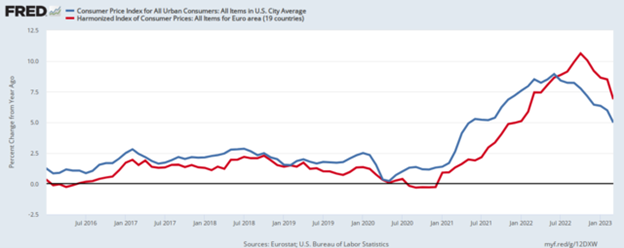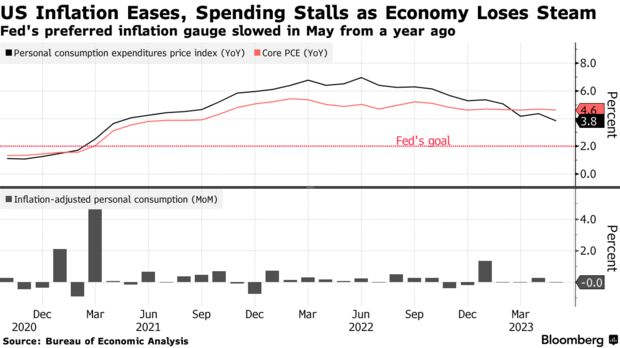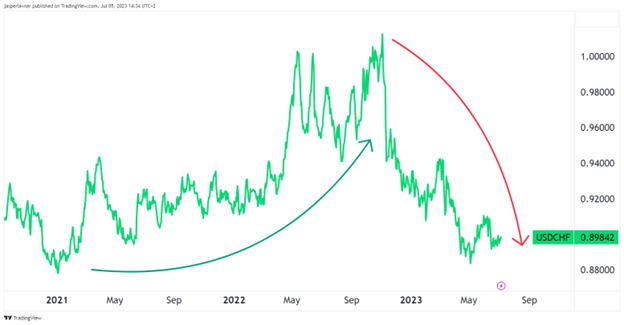Slowing inflation after the summer would be good for the cost of living but might be a bad omen for a recession.
The latest data from the US economy reveals a cooling in inflation measures and stagnant consumer spending, signaling less pressure on household budgets but also a loss of momentum in the country's economic engine.
European inflation topped after the US at a higher level but appears to be tracking a similar path. This makyese sense in that European prices rose more in the aftermath of the Russian invasion of Ukraine but are still broadly affected by the same global trend post-pandemic. As such we can make similar dedication about the future for inflation in Europe, but with a lag.

Big Picture
Inflation is projected to drop further in the next few months, partly due to the exclusion of significant price increases from the calculation compared to a year ago.
The end of substantial price hikes in groceries and a slight downward trend in new car prices contribute to the overall easing. Energy prices, including gasoline, natural gas, and electricity, also experienced a decline, but further reductions in these prices are unlikely.
3 measures of US inflation are slowing (but 1 isn’t)
- The PCE price index
A key indicator of inflation, increased by 0.1% in May, reflecting a slowdown in price growth. This figure represents the slowest pace seen in more than two years, suggesting some relief from elevated price pressures. However, the core PCE price index, which excludes food and energy, still rose by 4.6% from May 2022, indicating persistent inflationary pressures that remain well above the Federal Reserve's 2% target.

- Real Consumer Spending
Adjusted for prices, consumer spending remained unchanged in May, following a modest 0.2% gain in April. Household spending has experienced a notable slowdown after a surge earlier in the year. While spending on services increased, there was a decline in purchases of merchandise, particularly motor vehicles. The weak consumer spending figures contrast with other recent data indicating a resilient economy, primarily driven by a strong labor market.
- Services
Underlying the government report, a key metric highlighted a welcome slowdown in inflation. Services inflation, excluding housing and energy services, increased by only 0.2% in May compared to the previous month, the smallest advance since July of the previous year. Although this figure represents a year-on-year increase of 4.5%, it signals a potential easing of inflationary pressures in certain sectors of the economy.
- Core CPI
Excluding food and energy, core consumer price inflation (CPI) remains at 5.3% for the past twelve months through May and is expected to hover around 5% for the remainder of the year. Shelter prices, the largest component of the inflation index, continue to rise, although at a slower pace. The prices of other services, particularly in the core services component, show a moderate increase, with elevated price levels observed in restaurants.
Potential Economic Threats
While low unemployment and steady wage growth have sustained consumer spending, there are underlying concerns in the economy. Some households are relying more on credit cards as pandemic-related excess savings dwindle, and delinquency rates are on the rise. These factors, coupled with the expectation of tightening credit conditions, pose potential threats to the ongoing economic expansion.
Implications for Monetary Policy
Despite some progress in cooling inflation and slowing consumer spending, the Federal Reserve remains cautious. The inflation rate continues to exceed the central bank's 2% target, prompting officials to signal their expectation for two more interest rate hikes later this year, with the possibility of the first hike occurring in the upcoming meeting in July.
What’s next for USD/CHF?
The Swiss franc has completely reversed its losses since early 2021. This has teken USD/CHF full circle back to the crical 0.88-89 level. The franc strength reflects the relatively higher inflation in Europe and a suspicion that the Federal Reserve will not be able to hike interest rates much further without causing a recession. A break below 0.88 would confirm more franc-strength in the second half of the year. However, should it hold we can expect the currency pair to continue trading inside its 2-year price range.
USD/CHF (2-years)

Conclusion
The latest data indicates a cooling in US inflation measures and stagnant consumer spending, suggesting a loss of momentum in the country's economic growth. While inflation pressures have eased slightly, they remain above the Federal Reserve's target. The Federal Reserve is expected to resume hiking interest rates in the near future. Furthermore, although the economy has demonstrated resilience, concerns over credit card reliance and rising delinquency rates loom as potential risks to the ongoing expansion.




